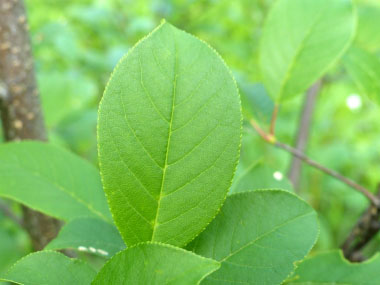









To support our efforts please browse our store (books with medicinal info, etc.).
Autumn Olive is a deciduous shrub that can grow quite tall. This shrub is native to Asia and was introduced into the U.S. in the 1830's. It was commonly planted for wildlife food and cover. The autumn olive shrub is easy to identify when it is in flower or once the fruits have matured. The leaves have a dintinctive silver underside.
Trunk/Bark
The bark is somewhat olive drab with many white lenticels. As it ages, the bark becomes light gray to gray-brown.
Branches/Twigs
Autumn olive’s young twigs are silvery with brownish scales giving them a speckled appearance. Thorns on young branches may be quite long.
Height
This bush can reach heights up to 6 metres (18') under optimum conditions.
Leaves/Needles
Autumn olive’s leaves are alternate and oval, with finely pointed tips. Their margins are wavy but do not have teeth. They are bright green above, and a distinctive silvery-scale below. Leaves range from 5 to 10 cm (2-4 in) in length. They occur in mid-March to mid-April depending on location.
Flowers
Autumn olive flowers are quite fragrant. They are cream or pale yellow, tubular with four petals and stamens, and are arranged in clusters of 1 to 8. They bloom from April to June and are insect pollinated.
Fruit
Autumn olive’s abundant fruits are silvery with brown scales when young and ripen to a speckled red in September and October. Fruits are eaten by a variety of birds, insects and mammals.
Habitat
Autumn Olive is shade tolerant but prefers dry sites. It is found in open woods, along forest edges, roadsides, sand dunes, and other disturbed areas. Autumn olive grows in many countries.
Edible Parts
Raw or cooked berries are edible. They have a pleasant taste that is slightly astringent. Autumn olives can be enjoyed raw and can also be made into preserves. The fruit must be fully ripe before it can be enjoyed raw.
Other Name
Japanese Silverberry.
Recipes
Autumn Berry Lemon Macaroons, Autumn Olive and Poppy Seed Cake, Autumn Olive Apple Crisp, Apple Sauce, Autumn Olive Berry Drink, Autumn Olive Cookies, Apple Jam, Lemon Bars
Winter Survival Food Handbook

PDF Plant Magazines
Types of Wild Food
Geographic Zones Seasons
Disclaimer
EdibleWildFood.com is informational in nature. While we strive to be 100% accurate, it is solely up to the reader to ensure proper plant identification. Some wild plants are poisonous or can have serious adverse health effects.
We are not health professionals, medical doctors, nor are we nutritionists. It is up to the reader to verify nutritional information and health benefits with qualified professionals for all edible plants listed in this web site. Please click here for more information.
Why Edible Wild Food?
- Food costs are rising
- Free, wild food is readily abundant
- Wild food adds nutrition to your diet
- Wild food can help treat various medical conditions





